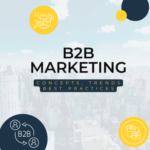A successful sales strategy depends on clearly understanding the differences between lead generation and demand generation in today's business landscape. At The Zulfis, we are dedicated to providing top-notch insights and strategies to elevate your business. This blog discusses the core differences between lead generation and demand generation, exploring their benefits and challenges and how they can be effectively implemented to increase sales. So, which is better for your sales: lead generation or demand generation? Let's find out.
Businesses now handle marketing and sales differently in the digital age. New strategies that more effectively grab the attention of new customers have replaced outdated methods. One important component of these strategies is comparing lead generation vs demand generation. Although they are compatible, they have multiple uses and require different strategies.
Furthermore, we specialize in helping businesses navigate these complexities, ensuring they adopt the right strategies to achieve their goals. Also, this blog clarifies the differences between lead generation vs demand generation, helping you determine which approach is better suited for your sales efforts.
Contact us now, and let's discuss how to achieve your goals together.
What is Lead Generation?
Lead generation focuses on identifying and capturing potential customers' interest in your product or service. This process involves collecting information from prospects, such as their name, email address, and other contact details, typically through forms on landing pages, webinars, or gated content.
How to Generate Leads
The first step is finding your target audience by identifying your ideal clientele. Next, you produce valuable content that attracts and engages your intended audience. For example, offering free materials like eBooks, whitepapers, or templates in exchange for contact details is a successful strategy. Creating efficient landing pages with forms is crucial for gathering lead data. Finally, advancing leads along the sales funnel by nurturing them through email marketing, customized content, and other strategies is essential.
Benefits of Lead Generation
Lead generation has several benefits. For instance, it captures direct contact information about prospects, allowing for personalized follow-ups. Additionally, it helps in segmenting and nurturing leads based on their stage in the buying process. In fact, the results are easily measurable through metrics such as conversion rates and cost per lead, making it easier to evaluate campaign effectiveness.
Challenges of Lead Generation
Lead generation comes with its own set of challenges. Balancing the quantity of leads with their quality is crucial for maintaining the sales team's efficiency. Also, to turn leads into clients, planned and constant follow-up is required. Moreover, large-scale lead data management and analysis can also be challenging.
What is Demand Generation?
Demand generation encompasses a broader range of marketing activities to create awareness and interest in your products or services. Rather than focusing solely on capturing leads, Demand Gen aims to build long-term brand recognition and establish a strong market presence.
How Demand Generation Works
First, strategies to increase your brand's visibility and recognition are essential. Next, creating high-quality, valuable content that educates and engages your target audience is important. For example, optimizing your online presence to attract organic and paid traffic through SEO and SEM is a key component. In addition, utilizing social platforms to connect with and engage your audience is crucial. Finally, hosting informative sessions to educate potential customers and showcase expertise through webinars and events is effective.
Benefits of Demand Generation
Demand generation has a significant benefit for long-term growth. Indeed, it builds a strong brand presence, fostering customer loyalty and advocacy. Further, it educates the market about your products, services, and industry, positioning your brand as a thought leader. In addition, it drives more organic and paid traffic to your website, increasing opportunities for lead capture.
Challenges of Demand Generation
Demand generation presents multiple challenges. To grow and maintain brand recognition, sustained commitment and persistent work are required. It also necessitates a large financial outlay for SEO, content production, and other marketing processes. Moreover, it may be challenging and require sophisticated analytics to gauge how demand creation efforts affect sales.
Don't miss out on the latest trends, tips, and strategies in the world of sales and marketing. Our blog is packed with valuable content that can help you stay ahead of the competition.

What's the Difference Between Demand vs Lead Generation?
Objective
- Lead Generation: Focuses on capturing contact information from potential customers to facilitate direct sales efforts.
- Demand Generation: Aims to create broad awareness and interest, building a foundation for long-term customer relationships.
Tactics
- Lead Generation: Utilizes targeted campaigns, lead magnets, and direct outreach to generate leads.
- Demand Generation: Employs content marketing, SEO, social media, and events to build brand presence and educate the market.
Metrics
- Lead Generation: Measures success through metrics like conversion rates, cost per lead, and lead quality.
- Demand Generation: Evaluates impact through metrics such as website traffic, social media engagement, and brand sentiment.
Integrating Lead Generation and Demand Generation
While lead generation vs demand generation serve different purposes, integrating both strategies can create a powerful synergy that maximizes your sales potential. Here’s how you can effectively combine these approaches:
Create a Balanced Content Strategy
Developing a mix of content that caters to both lead generation and demand generation objectives is crucial. For instance, lead generation content includes eBooks, whitepapers, case studies, and webinars that require users to provide contact information. On the other hand, demand-generation content comprises blog posts, infographics, videos, and social media updates that educate and engage a broader audience.
Use Data-Driven Insights
Leverage data analytics to understand your audience’s behavior and preferences. This will help you create targeted campaigns for lead generation vs demand generation and optimize your content for both.
Align Sales and Marketing Teams
Ensure your sales and marketing teams work closely together to align their strategies. Marketing should focus on generating high-quality leads and building brand awareness, while sales should prioritize nurturing and converting these leads into customers.
Implement Marketing Automation
Utilize marketing automation tools to streamline lead generation vs demand generation efforts. Automation can help manage lead nurturing campaigns, track engagement, and measure the effectiveness of your marketing activities.
Tips for Integrating Lead Generation and Demand Generation
- Unified Customer Journey: Map out a customer journey that includes touchpoints for both lead generation vs demand generation. This ensures a seamless experience from awareness to conversion.
- Content Repurposing: Create content that can serve both purposes. For example, a comprehensive guide can be gated for lead generation, while its summary can be shared freely for demand generation.
- Personalized Campaigns: Use the data collected from lead generation efforts to personalize demand generation campaigns. Tailored content can significantly enhance engagement and conversion rates.
- Regular Reviews and Adjustments: Continuously analyze the performance of your integrated strategy. Regularly review metrics and make necessary adjustments to optimize both lead generation vs demand generation efforts.

Elevate your business success with The Zulfis®! With over a decade of expertise in lead generation and list building, we provide unparalleled value. Experience our premium services with a complimentary sample; no commitment is required. Partner with us to drive your business growth—start today!
Trends and Technology: New Insights
AI and Machine Learning
Artificial intelligence (AI) and machine learning are revolutionizing both lead generation vs demand generation. AI-driven tools can predict customer behavior, personalize marketing messages, and automate repetitive tasks, enhancing efficiency and effectiveness.
Account-Based Marketing (ABM)
ABM is a highly focused business strategy in which a marketing team treats an individual prospect or customer like its very own market. Demand generation efforts can be tailored to target specific accounts, making marketing efforts more precise and impactful.
Interactive Content
Interactive content, such as quizzes, polls, and interactive infographics, can engage users more deeply. This type of content can serve both lead generation vs demand generation by capturing contact information while also increasing brand engagement.
Video Marketing
Video content continues to grow in importance. Short, engaging videos can be used for demand generation to build brand awareness, while more detailed explainer videos and webinars can serve as lead generation tools by requiring sign-up for access.
Wrapping Up
To sum up, demand and lead generation are essential components of a thorough sales strategy. Demand generation increases long-term brand exposure and interest, while lead generation obtains direct contact information from potential clients. By combining the two methods, businesses can ensure a well-rounded plan that maximizes sales potential. Additionally, businesses may establish an effective balance that drives development and success by aligning sales and marketing teams and utilizing data-driven insights.
At The Zulfis, we offer comprehensive services designed to boost your business's growth and success. Explore our services and find out how we can tailor our solutions to your needs.







